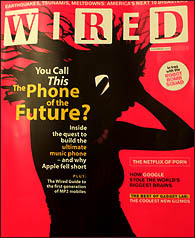
MacWorld is just around the corner, and with it endless speculation that 2007 will not only be the year Apple finally throws its hat into the mobile phone ring, but also the year that the promise of a musicphone that can actually substitute for your digital music player of choice finally comes true.
Of course, it’s all déjà vu to us. I’m pretty sure 2006 was supposed the year of the musicphone, and maybe even 2005 before that. There are many good reasons consumers haven’t really embraced music/phone convergence yet, and it isn’t just the lack of one made by Apple.
So what would it take to make the perfect (Apple or non-Apple) musicphone? Click the jump to see exactly what needs to be done before we all leave our iPods gathering dust for good…
The Problem: Undersized Headphone Jacks
Perhaps the single greatest impediment to the widespread adoption of musicphones is manufacturers inane insistence in stuffing the minuscule 2.5mm headphone jack on their products, as opposed to the 3.5mm jack found on regular MP3 players. Most people are loathe to use any sort of size-changing adapter, and the realization that your $300 pair of Shures won’t fit into your phone is usually enough to turn people off for a long, long time.
Of course, there’s a familiar reason you find the 2.5mms on 90% of phones, and it isn’t size constraints (if a super-slim Nano can fit a 3.5mm jack, your RAZR can). Rather, it’s our good friend Ye Olde Yankee Dollar. As a cell phone exec recently told me in confidence, if you need a separate pair of headphones, you’ve got to plop down more cash for more accessories. I can’t even begin to tell you how bad this attitude is for innovation, and I shouldn’t have to.
The Problem: Miniscule Memory
The RAZR, SLVR, and (god-forbid) the ROKR are marketed as musicphones, but once you’ve loaded in Bejeweled, your contacts, and a party’s worth of 1.3-megapixel pics, there’s barely enough space for enough music to get you through your morning commute. Unless a phone comes with more gigabytes than a Shuffle, I’m not leaving my DAP at home.
The Problem: Bulky Phones
Of course there are specially-marketed musicphones that DO pack in enough megs to hold your new Tom Waits boxed set. Take the Nokia N92—the Finnish 4-gigger. Unfortuantely, it’s sort of ridiculous that this phone, like most mobiles that pack in more than a gig or two, should be bulkier than a RAZR and Nano taped together. Unlike Asians or Europeans, Americans value tininess more than any bleeding-edge feature. Since DAPs like the Nano and the new Shuffle showed us just how small they can scrunch a couple gigs of memory, there is now officially no excuse for this pocket-stretching nonsense.
The Problem: Subpar Streaming Music
In the end, the future of musicphones will almost certainly be streaming content—their always-on wireless connectivity is a killer app that should make your Zune’s Wi-Fi cry. And anybody who needs a sneak peak into the tech’s potential need look no further than EV-DO-enabled phones like the Sprint A900 (aka.. the Blade). The phone’s lack of more than a couple megs of memory should be a non-issue if you’ve got a high-speed network streaming decent quality tunes (provided through licensing deals with Sirius.) Still, this bit of tech is way too young. Current EV-DO network limitations prevent you from even being notified of incoming calls while the tunes are streamed, making your phone useless as, you know, a phone. In addition, the available content is limited (Sirius only licenses a few of their music stations, and none of their talk—so no Howard), and the price is kind of ridiculous. Still, once your phone is able to keep you connected while rocking out, and decent content becomes available at a decent price, this will almost certainly be the future of musicphones. And, unfortunately, this is the one feature that Apple’s history suggests almost certainly will not be part of their first foray into cellphonery.

Seth Porges writes on future technology and its role in personal electronics for his column, The Futurist. It appears every Thursday and an archive of past columns is available here.